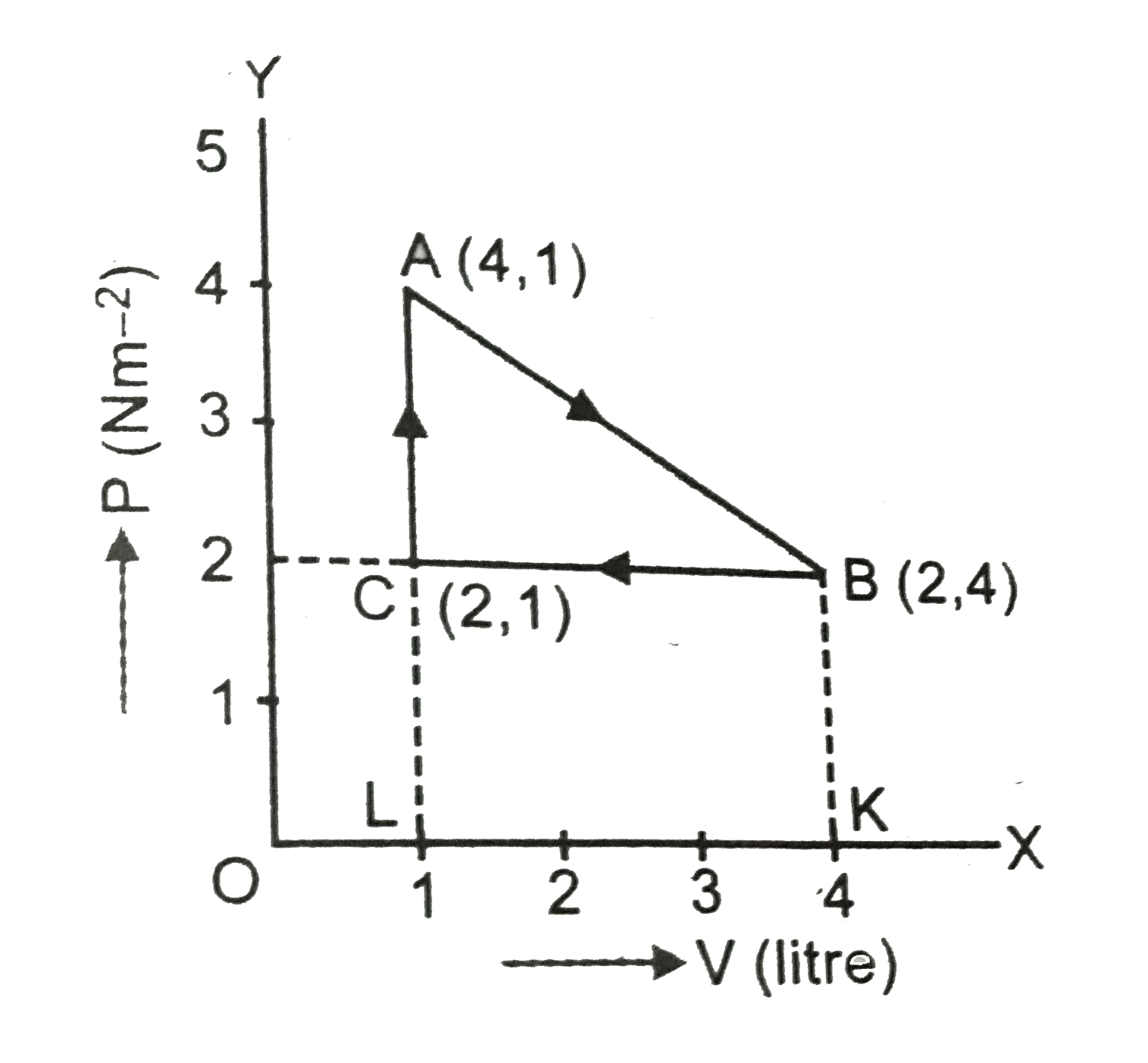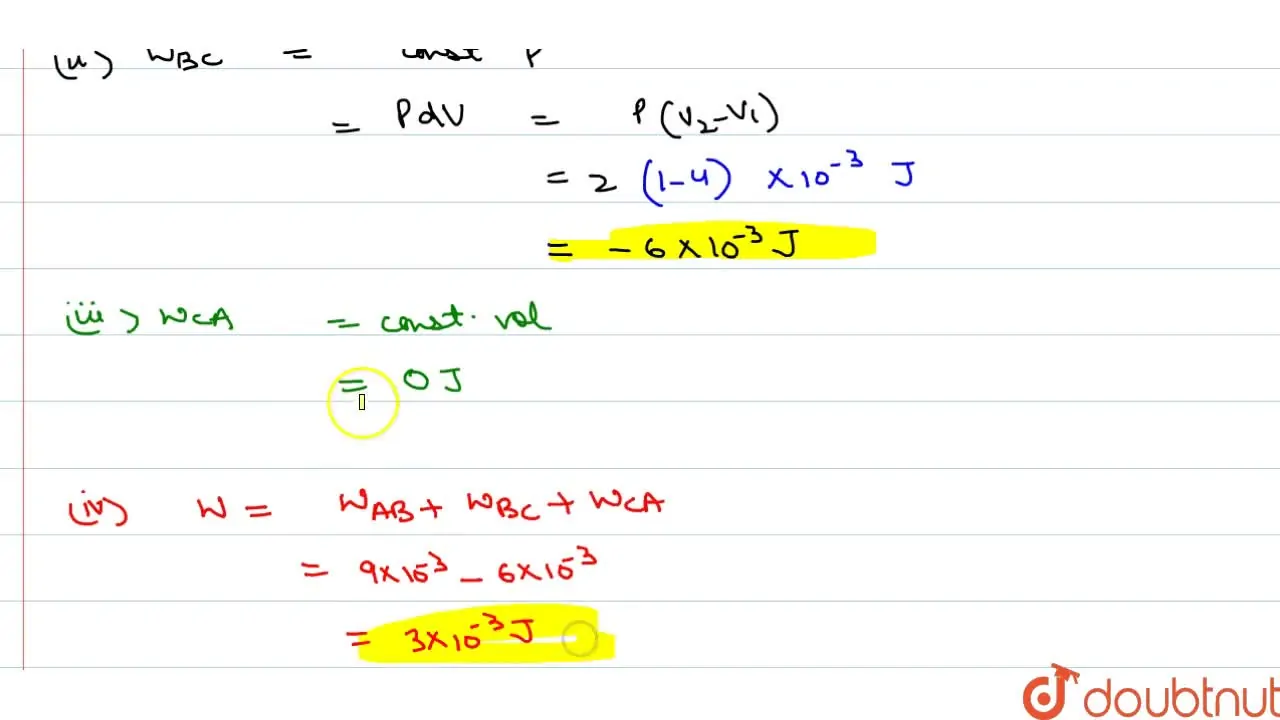The P−V diagram for a cyclic process is a triangle ABC drawn in order (figure). The co-ordinates of A,B,C are (4,1),(2,4)and(2,1) respectively. The co-ordinates are in the order (P,V) Pressure is in Nm−2 and volume is in liter. Calculate work done during the process from A to B, B to C and C to A. Also, calculate work done in the complete cycle.
The P−V diagram drawn as per the question in shown in (figure)

(i) Work done during the process from A to B
(expansion)
WAB=+areaABKLA=area ofΔABC
+ area of rectangl e BCLK
WAB=12BC×AC+KL×LC
Now, BC=KL=4−1=3litre
=3×103m3
AC=4−2=2Nm−2
LC=2−0=2Nm−2
∴WAB=12×3×10−3×2+3×10−3×2
WAB=9×10−3J
(ii) Work done during the peocess from B to C (compression) is
WBC=−areaBCLK=−KL×LC
=−3×10−3×2
=−6×10−3J
(iii) Work done during the process from C to A
As there is no change in volume of the gas in this process, therefore,
WCA=P(dV)=0
Net work done in the complete cycle
W=WAB+WBC+WCA
=9×10−3+(−6×10−3)+0
=3×10−3J
Note that the same value of W is obtained when we take area of the triangle ABC representing the cyclic process.
Related Playlists
- BOOK - PRADEEPCHAPTER - THERMODYNAMICSEXERCISE - Conceptual Problems22videos
THERMODYNAMICS
- BOOK - PRADEEPCHAPTER - THERMODYNAMICSEXERCISE - Very short answer questions31videos
THERMODYNAMICS
- BOOK - PRADEEPCHAPTER - THERMODYNAMICSEXERCISE - Curiosity Question2videos
THERMODYNAMICS
- BOOK - PRADEEPCHAPTER - SYSTEMS OF PARTICLES AND ROTATIONAL MOTIONEXERCISE - Assertion- Reason Type questions20videos
SYSTEMS OF PARTICLES AND ROTATIONAL MOTION
- BOOK - PRADEEPCHAPTER - WORK, ENERGY AND POWEREXERCISE - Assertion-Reason Type Questions24videos
WORK, ENERGY AND POWER
Similar Questions
ABCD is a parallegram. If the co-ordinates of A, B,C are (2,3), (1,4) and (0,-2) respectively, find the co-ordinates of D.
View SolutionAn ideal gas is taken round a cyclic process represened by the triangle ABC drawn in order on a P-V diagram. The coordinates of A, B, C are (4,1), (2,4), (2,1) respectively. The work done in the complete cycle is
View SolutionIn ΔABC , the co-ordinates of vertices A,B and C are (4,7) ,(-2,3) and (2,1) respectively . Find the lengths of its medinas.
View SolutionIf the co-ordinates of the vertices A,B,C of the triangle ABC are (−4,2),(12,−2)and(8,6) respectively, then∠B=
View SolutionThe co - ordinates of the centroid of a triangle ABC are (2,2) what are the co ordinates of vertex c if co ordinates of a and b (7,-1) and (1,2) respectively
View SolutionThe area of triangle ABC is 25cm2 .The co-ordinates of vertex A are (-6,0) and B are (4,0). The vertex C lies on the line,x-y=4 .The co-ordinates of C are
View Solution
Calculate the work done by a gas as it is taken from 1 to 2,2 to 3 and 3 to 1 as shown. Also calculate the work done in cyclic process 1→2→3→1View SolutionThe co ordinates of the base BC of an isosceles triangle are B(1,3) and C(−2,7) then the co-ordinates of its vertex A are
View SolutionThe co- ordinates of the centroid of a triangle ABC are (2,2) . What are the co-ordinates of vertex C if co-ordinates of A and B are (7, - 1) and (1, 2) respectively ?
View SolutionCalculate the work done in taking a charge of 0.02 C from A to B, if the potential at A is 20 V, and that at B is 30 V.
View Solution


